This is the first in a series of blog posts featuring other National Estuary Programs around the nation.
Header photo courtesy of Brandon Sawaya.
The Puget Sound Partnership
The Puget Sound Partnership (Partnership) is the Washington state agency and National Estuary Program leading the region’s collective effort to restore and protect Puget Sound. We bring together hundreds of partners to mobilize action and investments around a common agenda to protect and restore Puget Sound.
What makes Puget Sound special
Puget Sound nourishes the region’s health, economy, environment, and quality of life. It encompasses the southern half of the Salish Sea, which spans across international borders. Coast Salish people have stewarded these lands and waters, and fished, hunted, cultivated, and gathered throughout the region since time immemorial. Its snowcapped mountains and sparkling waters continue to attract people and businesses from around the world.
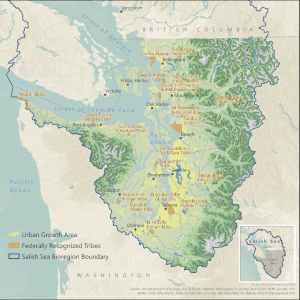
About Puget Sound
Puget Sound is a fjord estuary, which means its basins were carved by glaciers. Those deep basins make Puget Sound the second-largest estuary in the nation; it holds about 40 cubic miles of water. An estimated 2,800 streams, from rivers to creeks, flow into Puget Sound.
The Puget Sound coastal shoreline lies within twelve of Washington State’s thirty-nine counties. About seventy-five percent of Washington State’s population lives in those twelve counties that surround Puget Sound.

However, Puget Sound is not doing well. The Puget Sound ecosystem faces challenges that include the degradation of water quality, water quantity, and habitat; pollution from contaminants in stormwater and from other sources; and the effects of climate change, which include warming ocean and air temperatures, changes in precipitation patterns, and ocean acidification.
Species in Puget Sound
Puget Sound supports more than 250 fish species, 38 marine mammal species, 172 bird species, and a large variety of invertebrate species too.
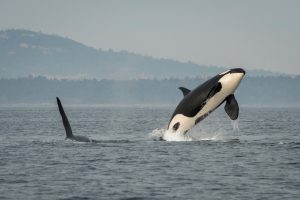
The Southern Resident orcas, which eat primarily Chinook salmon, range in the Salish Sea and along the West Coast of the U.S. and Canada. In the late 1990s, Southern Resident orcas experienced a dramatic decline in their population. The combination of dwindling Pacific salmon abundance and threats from pollution, vessel traffic, and noise continues to jeopardize the orcas. As a result, they are federally listed as endangered. As of the July 2022 census, there were 73 Southern Resident orcas.
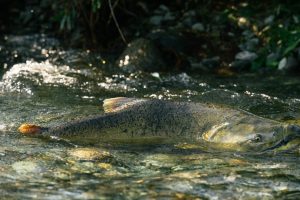
There are eight species of salmonids, fish in the salmon family, that use Puget Sound. These include Chinook, coho, sockeye, chum salmon, and pink salmon; steelhead and cutthroat trout; and bull trout. Three of those species are listed as threatened under the Endangered Species Act: Chinook salmon, steelhead, and bull trout.
History of the Partnership
Congress created the National Estuary Program (NEP) in 1987 and designated Puget Sound as an Estuary of National Significance in 1988. Between 1987 and 2007, there were various iterations of efforts involved in Puget Sound recovery. The Washington State Legislature then created the Puget Sound Partnership in 2007 as the state agency dedicated to coordinating and leading the effort to restore and protect Puget Sound. In this role, the Partnership also serves as the state’s salmon recovery lead organization.
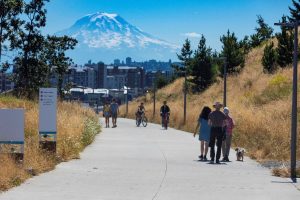
The role of the Puget Sound Partnership
We facilitate collaboration on Puget Sound recovery and provide leadership through the collective development of the Puget Sound Action Agenda (the community’s shared plan for recovery), progress measurements, and funding strategy.
Our role includes the following:
- ALIGN THE WORK OF PARTNERS around a shared vision and strategy, the Puget Sound Action Agenda (which is the Puget Sound NEP Comprehensive Conservation and Management Plan (CCMP)). The Action Agenda helps the recovery community allocate resources based on a science-driven, prioritized system.
- ENSURE SMART INVESTMENTS through a shared, science-based system of measurement and monitoring that promotes accountability, effectiveness, and progress. This helps inform decisions about the most efficient ways to allocate future investments.
- SUPPORT PRIORITY ACTIONS by promoting policy and advocating for funding needed for local and regional partners to succeed in achieving Puget Sound recovery goals. We strive to remove barriers for our partners by directing outside resources toward priority actions, improving the policy and regulatory environment, and working as a catalyst within the system to get the job done.
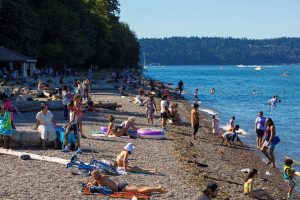
Puget Sound Ecosystem Monitoring Program
We also support and assist the Puget Sound Ecosystem Monitoring Program (PSEMP), which is a collaborative network of subject matter experts from many monitoring organizations throughout the region. Together, they generate and communicate scientific information to track Puget Sound ecosystem conditions.
Puget Sound Acquisition and Restoration fund
With the Washington State Recreation and Conservation Office, we co-administer the Puget Sound Acquisition and Restoration (PSAR) fund, which supports projects that recover salmon and protect and recover salmon habitat in Puget Sound.
PSAR investments have helped restore and protect over 3,300 acres of estuary habitat, more than 150 miles for fish passage, and over 14,000 acres of watershed habitat. These projects support multiple benefits in addition to Puget Sound salmon, including climate resilience and flood protection, recreation, and tribal treaty rights.
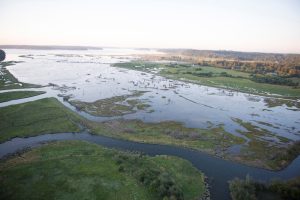
Our partners
We work with tribal nations, federal government agencies, congressional delegation, state agencies, local governments and local organizations, nonprofits, representatives from businesses and agriculture, and community members.
Help us protect and restore the Morro Bay estuary!
- Donate to the Estuary Program today and support our work in the field, the lab, and beyond.
The Estuary Program is a 501(c)3 nonprofit. We depend on funding from grants and generous donors to continue our work. - Support us by purchasing estuary-themed gear from ESTERO. This locally owned and operated company donates 20% of proceeds from its Estuary clothing line and 100% of Estuary decal proceeds to the Estuary Program. Thank you, ESTERO!
- Purchase items from the Estuary Program’s store on Zazzle. Zazzle prints and ships your items, and the Estuary Program receives 10% of the proceeds. Choose from mugs, hats, t-shirts, and even fanny packs (they’re back!) with our fun Estuary Octopus design, our classic Estuary Program logo, or our Mutts for the Bay logo.
- We want to hear from you! Please take a few minutes to fill out this short survey about what type of events you’d like to see from the Estuary Program. We appreciate your input!